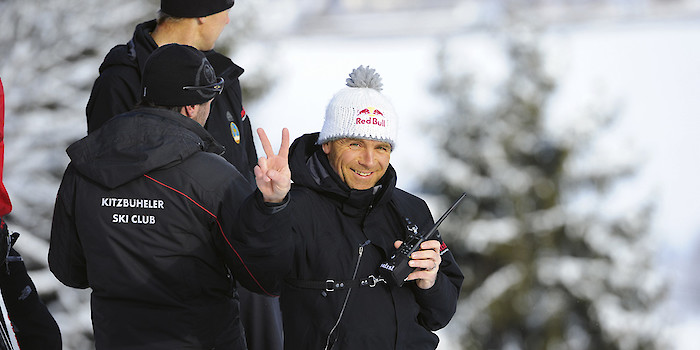HKR 2017
Chief of Race Axel Naglich on the fundamental idea behind the Europacup
13.01.2017
In recent years, Axel Naglich has travelled to the worlds biggest mountains and pioneered some of the most extreme ski-routes. His greatest dream came true when he rode the longest vertical descent in the world, “Mount St. Elias”, together with Peter Ressman in 2007.
Axel, you were a forerunner on the Streif for 11 years. What do you remember best?
The very first time was incredible. I wasn't really a ski racer and not used to skiing in a downhill racing suit. It made me much faster than I was accustomed to when skiing in normal skiwear. When I got down I thought to myself, ‘How did I get to the finish line?’ I don’t even want to see the video of how I made those turns. You can only say how the Streif feels, after skiing down it for the first time.
Today you are Chief of Race at the Hahnenkamm Races. Where is there still potential? What do you envisage for the future?
There is room for improvement everywhere. The only limitation is the course record set by Frotz Strobl in 1997, which seems to be set in stone. We can make improvements and optimize the spectator areas. There is no limit!
As FIS Technical Delegate, you are already acquainted with the Europacup Races. Is that how you came up with the idea of hosting a Europacup Downhill in Kitzbühel.
The Europacup is the “little brother” of the World Cup and hosting it amounts to not even a fraction of what it costs to host World Cup events. In a sporting sense, the problems we encounter are similar because a slope is required of similar quality to those of the World Cup, set-ups, racecourse safety and so on. Athletes competing in the European Cup are not significantly slower, the courses are just selected so six kilometres of A-nets are not required, as no race organizer is able to afford them. Our goal is to introduce Europacup athletes to the Streif.
To ensure the ski racing future of the Streif?
Exactly, that was the basic idea. If we don’t have any world cup racers on the Streif, there is no future for the Hahnenkamm Downhill. This is, of course, something that costs more than it is worth. But we can look at the European Cup as an investment for the future World Cup athletes on the Streif.
To then concentrate on what in the World Cup?
The complete Streif. The full version of the Streif would make no sense for European Cup participants. The leap from the European Cup to the Streif in its entirety is no laughing matter.
Where is the start and finish at the European Cup in Kitzbühel?
Mausefalle and Steilhang at full speed is not so great for young skiers, which is why the European Cup will start at the Reserve Start 1, above the Mausefalle. The finish line at Oberhausberg. We do not want to expose European Cup contenders to the Hausberg yet. Ideally, this means that if an athlete has experienced the EC Streif course during two training runs and one race, he is well acquainted with over 50 per cent of the course.
Have athletes in the European Cup and/or nations come to your attention that will be future contenders for the full-size Streif?
Certainly, it is the usual constellation. The Austrians and Norwegians are strong. There are also good Swiss, Italian, French and German athletes. But I cannot say who will ultimately become one of the world’s elite. At the end of the day, we know that five European Cup athletes are the world champions of the future.
Will a European Cup be held every year in Kitzbühel?
We have decided to host the European Cup Downhill bi-annually, alternating year on year with the Junior Race. In other words, the EC will take place every two years. We need to make our first experiences with the European Cup before we can plan the future.
How do spectators get to the finish line at the European Cup?
You can ski down the Parallel Streif directly to the finish line, where there will be a video wall with scoreboard, music and commentators. 
